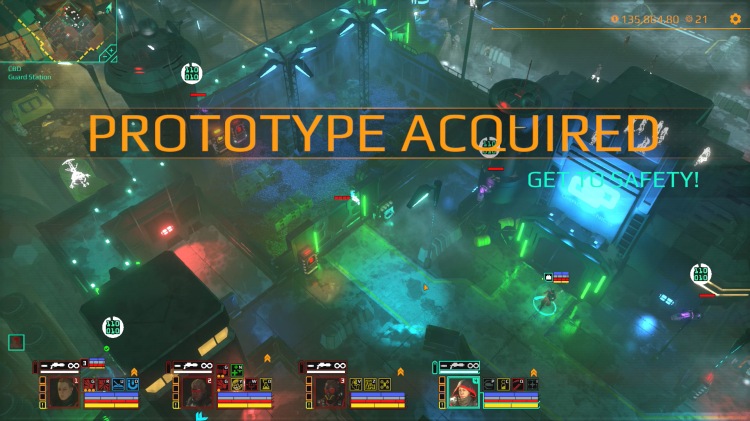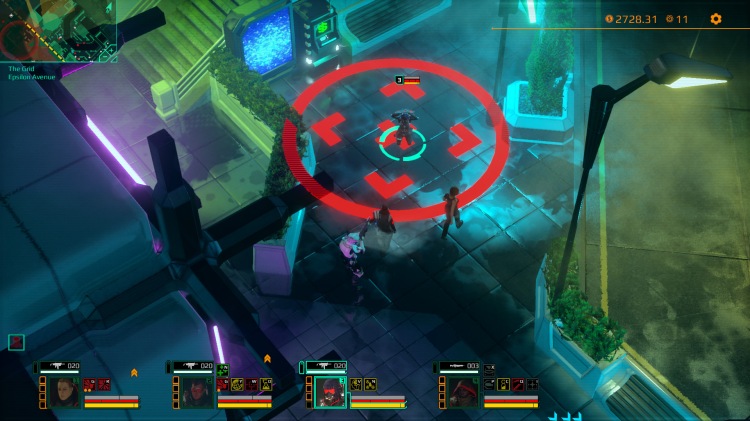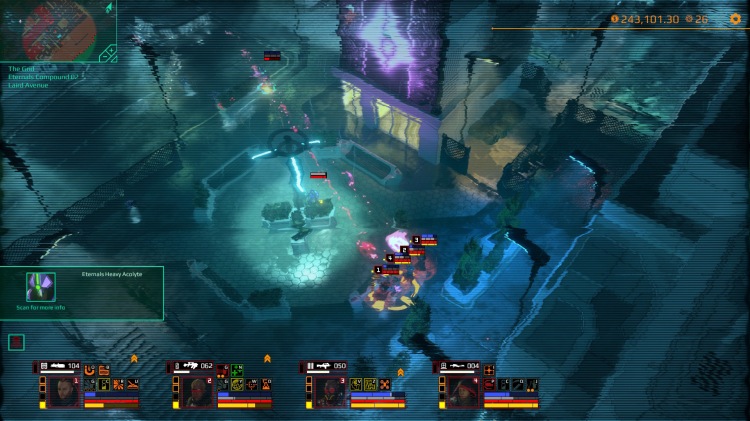
Satellite Reign is an isometric open-world real-time strategy (RTS) game that pays homage to the Syndicate games of the 1990s. I wrote an optimistic first impressions piece back in February, but now it’s time for my final verdict.
Combining the aesthetics of Ridley Scott’s Blade Runner with the themes of William Gibson’s Neuromancer, Satellite Reign is a grimy night world of perpetual rain that blends American consumerism with cyberpunk Japan; a tech-noir future of body augmentations and neural implants ruled over by the mega-corporations. Oppressive and mesmerising in equal measure, Satellite Reign’s isometric cityscape looks and sounds gorgeous. A sprawling labyrinth of rain-lashed alleyways, rundown buildings, grimy walkways and gaudy plazas. Steam pours from vents, neon glistens off the water-slickened surfaces; the dank streets illuminated by the glow of billboards, holographic trees and corporate art. Colourfully-dressed cyberpunks swagger along by, hover cars swish past, bums sleep among the debris, brutal security forces maintain order. The mood is brilliantly complemented with a soundtrack from Russell Shaw (Syndicate games, Black and White) and other contributors that mashes Vangelis with synthwave.

It’s a joy to behold and an impressive evolution of the comparatively rudimentary mini-sandbox environments of the original Syndicate games, to which Satellite Reign justifiably considers itself a “spiritual successor” (see my earlier piece). But you’ll probably be disappointed if you expected a straight clone of those games. Here the emphasis is on stealth and subterfuge – it’s basically Commandos with an RPG element. The pace is significantly slower and all-out gunfights are more of a last resort than a direct approach. Enemies are much tougher (i.e. bullet spongy) and will attempt to call in reinforcements. While installations are protected by a variety of security measures that you’ll need to avoid or overcome. Instead, your agents spend much of their time hiding in the shadows, sneaking around using the game’s point-and-click cover system. Patience and observation are important and you need a plan. There are always multiple approaches. Scouting out quiet side-entrances or vents and zip lines that can provide access is crucial; sometimes you can just bribe a soldier to let you through a door.

Once in, you’ll be relying heavily on the special abilities of your four trench-coated cyberpunks. The hacker can temporarily disable cameras and turrets, unlock doors and hijack neural implants, allowing you to take control of NPCs for a bit of mischief. The infiltrator is both a sniper and a stealth operator, the best option for taking down guards silently. The soldier is the brute force of the squad; useful to have around if the shit hits the fan, but they can also disable power generators, shut off gas vents, and force open (hardwire) certain doors. The support is the medic of the team as well as providing intelligence; their scans reveal targets and how doors and security systems connect to data terminals and power generators.

Satellite Reign is not what you’d call a plot-driven game (narrative snippets can be gleaned from scanning data caches, but that’s totally optional). After a brief intro and short tutorial, you’re left to get on with it. Working for a shadowy organisation of unspecified motive, the aim is to bring down Dracogenics. They’re a mega-corp who’ve seen a meteoritic rise to power thanks to ResTech, a satellite-based resurrection system that allows those that can afford it to carry on living forever; die and simply get uploaded into a new body. The same technology is behind the game’s relay beacons, which function as a checkpoint, resupply, fast travel station and shop. First, you need to finance your operation and get your agents up to scratch by taking on an array of side-missions. These can be attempted in any order and as you progress new districts open up and more missions become available. Some provide rewards on completion that will help with more difficult assignments, such as debuffs to security forces in certain locales; while others provide prototypes that you can research and eventually supply to your guys and gals. Eventually, you’ll be ready to storm the Dracogenics HQ.
It’s all a bit daunting at first and there is a lot to take in, there’s certainly a bewildering number of (comically oversized) weapons, gadgets, augmentations and abilities to consider. However, they’ve made the mistake of confusing quantity for complexity. The difficulty doesn’t scale well with your progress and by the later stages missions become by-the-numbers affairs. Money is only an issue early on; getting your hacker to place syphons on the ATMs scattered throughout the city provides a slow but steady income stream. While the black market allows you to get your hands on any prototype instantly, rather than having to acquire them through hard work.

As your agents level up and acquire new abilities and gadgets, they simply become too strong. Upgrading health and equipping your soldiers with shields and armour turns them into tanks, while the pack mule skill negates difficult equipment choices and some of the gadgets/upgrades allow agents to perform each other’s roles. The infiltrator becomes especially overpowered. Give them the hacker by proxy gadget and max out their cloak and melee attack abilities and they become a one-man stealth-army, with little need for the rest of the team. The soldier’s hardwiring skill is also far too useful, allowing you to easily disable multiple security systems by shutting down power generators.
Disabling saves while inside restricted areas was a good move, but there’s still not enough sense of risk. Agents respawn at relay beacons with all their skills, equipment and XP intact, and downed agents can be resuscitated within a given time frame. It’s far too easy to shoot your way out of trouble, especially after some upgrading. Conveniently, every soldier you kill drops an ammo pack and there are replenishment points within enemy compounds, so running dry is rarely an issue. Whereas conspicuous corpses don’t pose a risk, they despawn after just a few seconds and guards don’t notice them anyway. The game does feature a GTA-style wanted system and the mech units they send after you are genuinely terrifying, but it’s too easy to hide and it doesn’t take long before the alert state returns to normal. 5 Lives Studios have subsequently added in some difficulty settings. Ironman mode means that agents are reset upon death, while the uber damage option increases the damage taken by all units. They do help, but upgraded agents are still pretty bullet spongy and these options fail to address the other balance issues. Of course, you can create your own challenges, but it takes away responsibility from the developer.

I also found the mission variety underwhelming. Most objectives boil down to infiltrating yet another a heavily-fortified compound and nearly always culminate in walking through and then immediately back out of a bloody huge door; it’s the same mechanic whether you’re disabling a security system, robbing a bank, stealing tech, escorting a VIP, etc, and it feels like a bit of a cop-out. New districts may have their own distinct personalities, but the facilities you breach are a little too samey for my taste. It doesn’t help that you end up returning to the same locations on numerous occasions for unrelated assignments. I must admit, in the end, I found it a bit of a chore to finish.

Perhaps most disappointingly, your actions have no meaningful impact on the city. Nothing changes when you complete a mission and, aside from the occasional interaction between police and civilians, very little happens outside of the restricted areas. One of the things I loved about the original Syndicate games was the sense of chaos and the wake of destruction you left behind. And though there is environmental destruction in Satellite Reign, it’s fairly minimal; blood and gore are barely noticeable, corpses disappear, and everything gets magically repaired after a short while. It’s like the last five minutes didn’t happen. It all feels somewhat sterile and an injection of spontaneity or chaos would go a long way. There was talk of a reputation system that would affect how the populace interacted with your agents, but it clearly got shelved.

Although Satellite Reign came out of early access in August, it’s still plagued with technical issues. The game is in desperate need of further optimisation. The Unity engine it’s built on seems to be unable to use more than one CPU core, which heavily impacts framerate; in heavily populated areas and during intense action it’s borderline unplayable. The performance also noticeably degrades over time, though this can be resolved by restarting the client. It’s also riddled with bugs and visual glitches, while the AI is flaky as hell. Sometimes it works brilliantly, enemies exploit cover, work together, push up and attempt to flank. Other times they’ll just sprint into the middle of your guys or run around in endless circles. NPCs getting stuck on props is a constant frustration. Whereas you can’t take your eyes off your own operatives for a second; many a stealth-run has been thwarted by unexpected behaviour and dodgy pathfinding. That said, 5 Lives Studios are still releasing semi-regular “nightly builds” (and the main reason I delayed my review) and credit to them for continuing to support the game. Hopefully, some of the issues can be resolved.

Satellite Reign feels like a missed opportunity and in my opinion, it failed to deliver on the potential it showed in early access. Though perhaps I shouldn’t be too hard on 5 Lives Studios, this is an ambitious game made by a small independent studio on a tight budget. It’s certainly not a bad game, but it could be so much better. I love the premise and the tech-noir cityscape is beautifully presented and lovingly crafted. And it does feel like a natural evolution of the Syndicate games it pays homage to. The gameplay can be very rewarding at times, especially when you plan, coordinate and successfully execute a precision stealth-run, and there are genuine moments of tension and firefights can thrill. However, it’s not as challenging or as deep as it initially appears. The missions fast become repetitive, and too many upgrade options and too little risk ruins the difficulty balance. While technical issues make it seem too rough around the edges.

I like your review style, Stevie. Very authentic :). Would love to feature your reviews in our weekly curated email digest that goes out to thousands of people.
LikeLike
Thanks! And that would be great. What do I need to do?
LikeLiked by 1 person